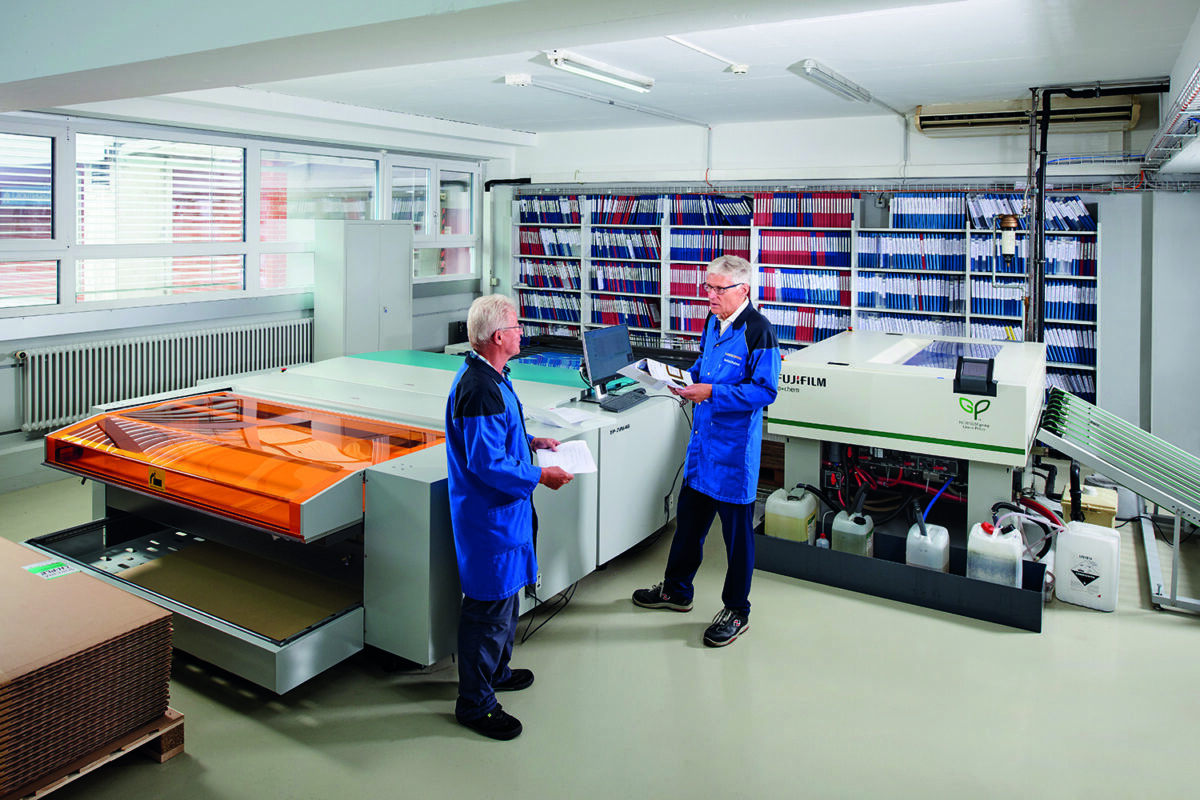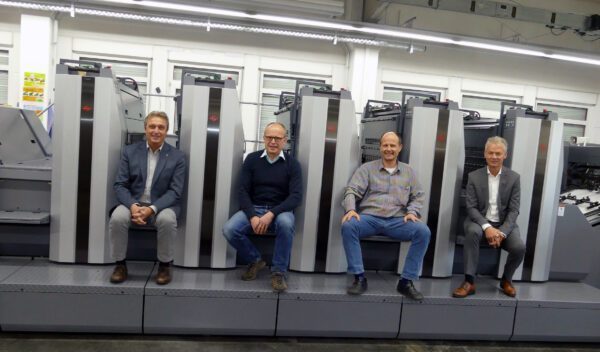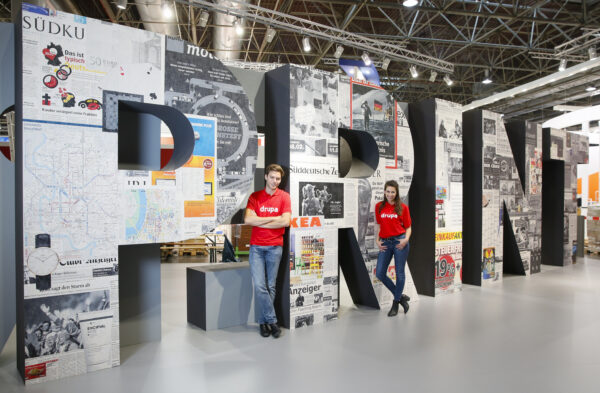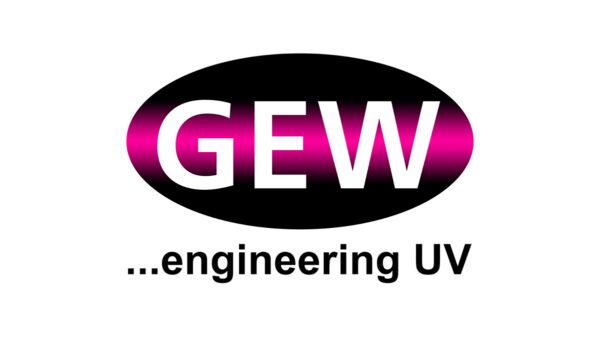Hoffmann Neopac AG, a company with a long tradition, has "Tins and Tubes" as an additional claim to its company name. The metal for the cans is printed on large-format sheet-fed offset presses at the site in Thun (The Tin). For almost two years now, the printing plates have been imaged on a VLF CtP system from Cron, a Chinese manufacturer. What many people don't know: Cron is now the world's largest CtP system manufacturer in terms of unit numbers, with over 30 installations in Switzerland alone.
Text: Paul Fischer / Image: Chromos Group
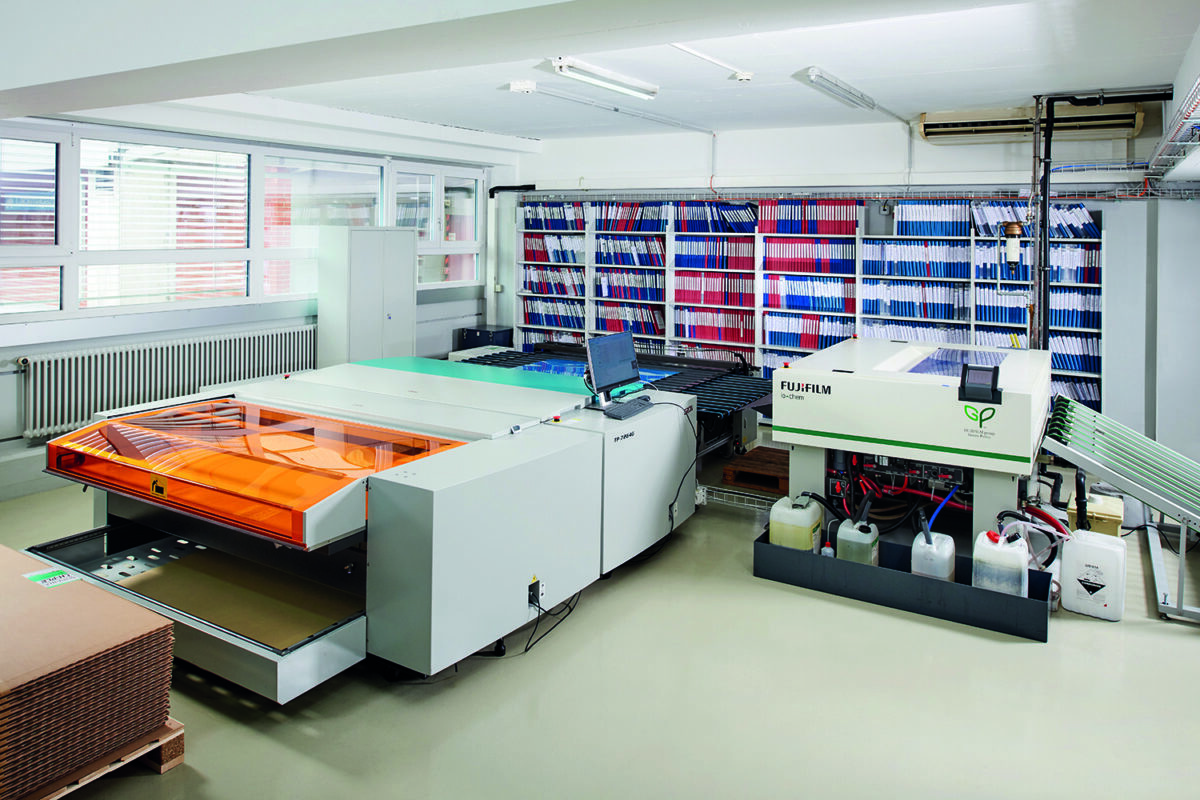
In the beginning there was the bolt-action rifle
130 years ago, in 1890, Eduard Johann Hoffmann founded a company in Thun that manufactured cartridge loaders made of cardboard and metal for the then brand new "1889 repeating rifle". The rifle was the standard weapon of Swiss militia soldiers until the famous "Karabiner 1931". However, the armaments business did not last long, and the Swiss Federal Ammunition Factory Thun (now Ruag Ammotech) soon took over the order. The Hoffmann company switched to its core business, the production of tin cans and metal packaging, which still exists today. In addition, the company continued to produce cardboard packaging, a line of business from which it has now completely divested itself.
In 1934, Union AG from Oberdiessbach, which also produced metal packaging, was taken over. The company was later renamed Neopac AG, and production of plastic tubes began in 1954. In 1965, the patented Polyfoil tube was introduced, a technical revolution at the time. Since 1998, the company has been called Hoffmann Neopac AG, and the focus on the two sites in Thun as a competence center for metal (The Tin) and Oberdiessbach (The Tube) as a competence center for tubes has been consistently pursued. Hoffmann Neopac AG is now globally active: Hoffmann "The Tin" with 140 employees in Thun produces 200 million cans per year. CM Packaging in Dronten, the Netherlands, was acquired in 2019 and, with over 50 employees, primarily produces metal packaging for the tobacco industry.
Neopac "The Tube" in Oberdiessbach with 370 employees produces 540 million tubes per year. There is also Neopac Hungary with 170 employees and 280 million tubes. Since 2017, the company has been owned by Neopac 3D, based in Mumbai, India. The third-largest tube manufacturer in India produces 150 million tubes per year with 550 employees. And last but not least, there is Neopac USA with an annual capacity of 80 million tubes. The strategy of the entire company is clearly formulated: at the sites in Switzerland, the focus is on innovation and products with high added value for global customers with corresponding demands. The expansion of the foreign sites is primarily aimed at establishing a presence in the regional and continental markets.
That's why you rely on Cron
Gerhard Wallner is Prepress Production Manager at Hoffmann Neopac AG in Thun. He is not just any Prepress Manager, but THE Prepress Manager. This is because the entire prepress department is based here in Thun, which means that Oberdiessbach is also supplied by his team. It's a comprehensive, complex task. When he talks about his day-to-day work, it quickly becomes clear that the "clocks tick differently" here than in traditional commercial print shops.
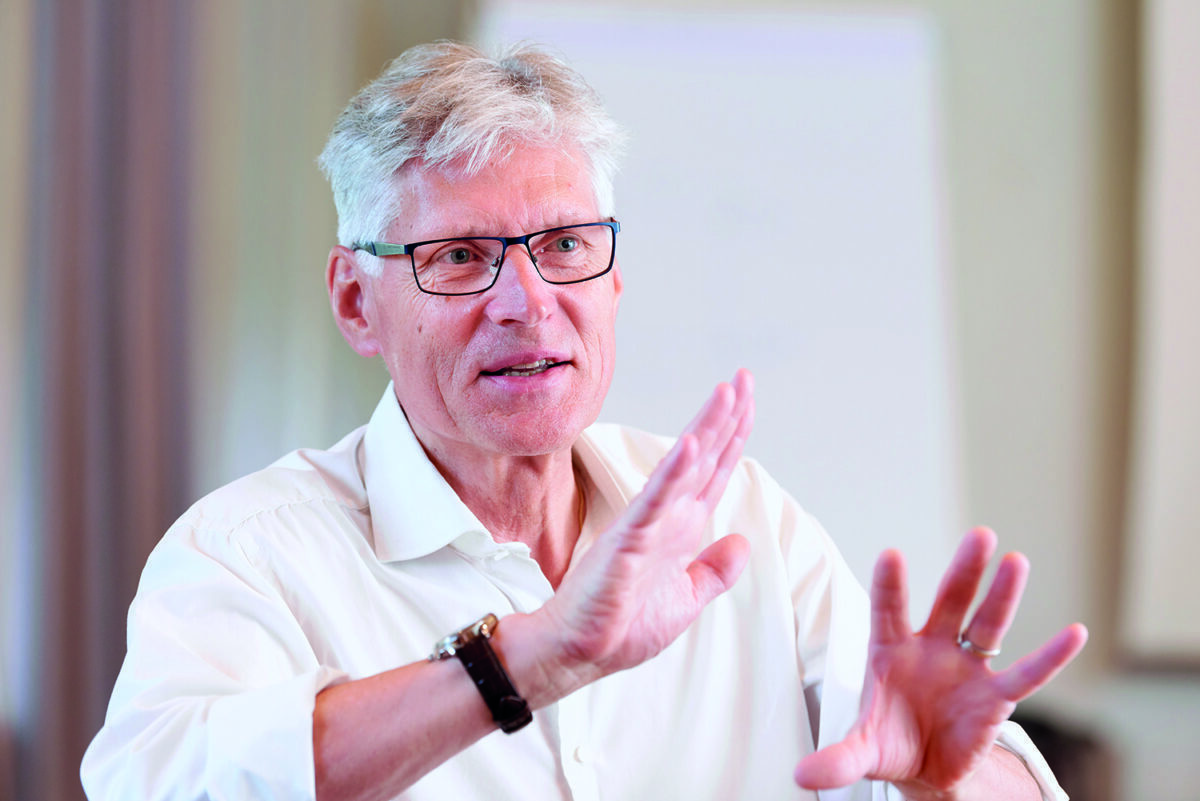
Gerhard Wallner: "I used to work in companies like this. Speed and flexibility were important there. Sometimes the odd mistake can occur, and you can deal with that. But the situation is completely different in can or tube production. These materials are much more expensive than cardboard and paper. Against this background alone, it is therefore extremely important for us not to make any mistakes. That's why we don't get involved in experiments. The technologies we work with have to be absolutely reliable and mature."
The predecessor CtP-VLF imagesetters, which had been in use for almost twenty years, were also mature. There was a need for action here. However, the initial situation was not so simple. Gerhard Wallner: "There are not so many potential suppliers of VLF CtP systems today. We looked at the systems in question until Chromos, which has been supplying us with Fujifilm printing plates for many years, drew our attention to Cron. At first I thought: 'Hm, Cron, a Chinese supplier. Never heard of them before. And to be honest, I was skeptical at first. Chinese products and reliable high-tech? I wasn't entirely comfortable with that. But after familiarizing myself with Cron's products and visiting users, I quickly realized that we were dealing with high-quality products."
A visit to Cron
In the fall of 2018, the author of this report had the opportunity to visit Cron in Hangzhou. Here are the impressions that were written down at the time: An interesting topic is Hangzhou Cron Machinery & Electronics Co Ltd in Hangzhou, the capital of a province known for its rich historical and cultural heritage. This is where the Cron company is located. Who or what is Cron?
The company was founded by a university professor specializing in the graphics industry. The company produced various devices for graphic applications and began developing CtP systems in 1996. In 2014, the company entered into a joint venture with the US company ECRM and, according to its own estimates, Cron sold the most new CtP systems worldwide in 2018.
In Switzerland, Thomas Früh and the Chromos Group represent the company and there are now already over 30 systems in this country. These include some very prominent printing companies from the packaging sector. Thomas Früh welcomed the study tour group in Hangzhou and described with great enthusiasm the development that the company has undergone in recent years. Of course, Cron CtP systems are somewhat cheaper than their competitors in terms of price, but according to his assessment, there is a completely different point that has made Cron the global number 1 in the CtP system market.
Thomas Früh: "In contrast to the Western and Japanese CtP system providers, who have shifted their development budgets to the digital printing sector, Cron has continuously developed its CtP systems and produced technical innovations. During a tour of Cron's production facilities, the study group was able to see for themselves the high level of quality that is produced here. The centerpiece is cylinder grinding, which is carried out on site using high-precision machines. The Cron case gives food for thought. Here, in the middle of China, proven high-tech is being built. While the entire graphic arts world is fascinated by what is happening in the competition for the future technology of digital printing, it is easy to forget that most graphic arts companies will need conventional but modern production technology of good quality, high performance and affordable investment costs for years to come. And such technology is increasingly coming from China. It no longer has much to do with cheap or copy-paste."
Wallner's conclusion
What were the reasons for Hoffmann Neopac to invest in the new CtP system from Cron? Gerhard Wallner: "First of all, the machine is very sophisticated. This has also been confirmed in practice. Previously we worked with two systems, but today we only have one Cron CtP platesetter in use. Since we installed the machine, it has been running reliably. Of course, there are situations where we need service support, but with Thomas Früh, who operates from Switzerland, and the additional support from the CHROMOS Group, we are well served. Especially in the last few months with the Covid-19 pandemic, the point about the regional or local availability of service technicians proved to be absolutely essential."
However, Gerhard Wallner emphasizes that he would like to increase the security factor. The purchase of a second device is now under discussion, not because he is dissatisfied, but because it is better to work with a backup CtP system in the long term. There is also another reason: "There are now fewer and fewer users of large-format sheetfed offset presses in Switzerland. This also means that we have fewer and fewer alternative options for imaging our plates there in an absolute emergency." Of course, the price played a role in the investment decision. Gerhard Wallner: "It's fair to say that the Cron CtP platesetter was cheaper than its competitors' products." However, it should also be noted at this point that pure system price comparisons are a difficult matter anyway. Many investment decisions in the CtP platesetter segment today are made in connection with plate contracts.
Hoffmann Neopac obviously didn't want that. Gerhard Wallner admits: "The price difference naturally made the decision easier, but that alone was not an argument. On the contrary, as already mentioned, Thomas Früh and Chromos had to dispel my initial skepticism." And there is another important "pro-Cron" argument. Gerhard Wallner: "The Chinese are extremely flexible. All other suppliers only ever offer us systems that are in a line and therefore require space. We didn't have that. Cron offered us a complete, angled system without any additional effort. The other applicants, on the other hand, did not respond to our wishes at all."
Gerhard Wallner summarizes: "Today, Cron offers sophisticated and, it has to be said, innovative CtP platesetters. In discussions with suppliers, we sense that the further development of CtP systems is no longer on their agenda. For Cron, on the other hand, it is their core business. And because they are not associated with one of the major plate suppliers, they have other priorities. China and reliable high-tech - that obviously works. I wouldn't have expected it in this form. But it's a fact."
Hoffmann Neopac (hoffmann-neopac.com), Report Hoffmann.pdf (gpsystems.ch)
